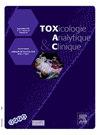HRMS and molecular networking
IF 1.7
Q4 TOXICOLOGY
引用次数: 0
Abstract
Objective
High-resolution mass spectrometry (HRMS) represents a significant advancement in analytical toxicology, enabling the acquisition of large datasets with high accuracy. However, the bioinformatic reprocessing of these data can be limited and constrained by commercial software. Molecular networking (MN) uses bioinformatics tools that facilitate the reprocessing of mass spectrometry data through open-access softwares, allowing for the visual grouping of structurally related molecules within samples.
Methods
Using raw data acquired by HRMS/MS, various software programs allow for filtering and reprocessing to generate outputs compatible with graphical softwares. Beyond facilitating the annotation of known compounds within complex samples, this methodology also enables the identification of new metabolites of xenobiotics, presenting many opportunities in clinical and forensic toxicology. Here, we present three original intoxication cases that illustrate the utility of MN to (i) determine which new psychoactive substances have been consumed, (ii) explore the metabolism of the hallucinogenic drug 25E-NBOH, and (iii) visualize complex LC-HR-MS/MS datasets across multiple biological matrices.
Discussion
Molecular networking is a versatile tool that enables the bioinformatic reprocessing of HRMS data in clinical and forensic toxicology. It can also support the study of xenobiotic metabolism through data reprocessing from in vivo or in vitro experiments, making it a preferred tool for such analyses. However, this method is time-intensive and requires sophisticated software, which may limit automation.
Conclusion
Molecular networking is a highly visual tool that allows for semi-quantitative and in-depth analysis of HR-MS/MS data, providing valuable insights for toxicological research.
HRMS与分子网络
目的:高分辨率质谱(HRMS)代表了分析毒理学的重大进步,能够获得高精度的大型数据集。然而,这些数据的生物信息学再处理可能受到商业软件的限制和约束。分子网络(MN)使用生物信息学工具,通过开放获取软件促进质谱数据的再处理,允许对样品中结构相关分子进行视觉分组。方法利用HRMS/MS采集的原始数据,通过各种软件程序进行过滤和再处理,生成与图形软件兼容的输出。除了促进对复杂样品中已知化合物的注释外,该方法还可以鉴定异种生物的新代谢物,为临床和法医毒理学提供许多机会。在这里,我们提出了三个原始中毒病例,说明了MN在以下方面的效用:(i)确定哪些新的精神活性物质已经被消耗,(ii)探索致幻觉药物25E-NBOH的代谢,以及(iii)可视化跨多种生物基质的复杂LC-HR-MS/MS数据集。分子网络是一种多功能工具,可以对临床和法医毒理学中HRMS数据进行生物信息学再处理。它还可以通过体内或体外实验的数据再处理来支持外源代谢的研究,使其成为此类分析的首选工具。然而,这种方法是耗时的,需要复杂的软件,这可能会限制自动化。结论分子网络是一种高度可视化的工具,可以对HR-MS/MS数据进行半定量和深入分析,为毒理学研究提供有价值的见解。
本文章由计算机程序翻译,如有差异,请以英文原文为准。
求助全文
约1分钟内获得全文
求助全文

 求助内容:
求助内容: 应助结果提醒方式:
应助结果提醒方式:


